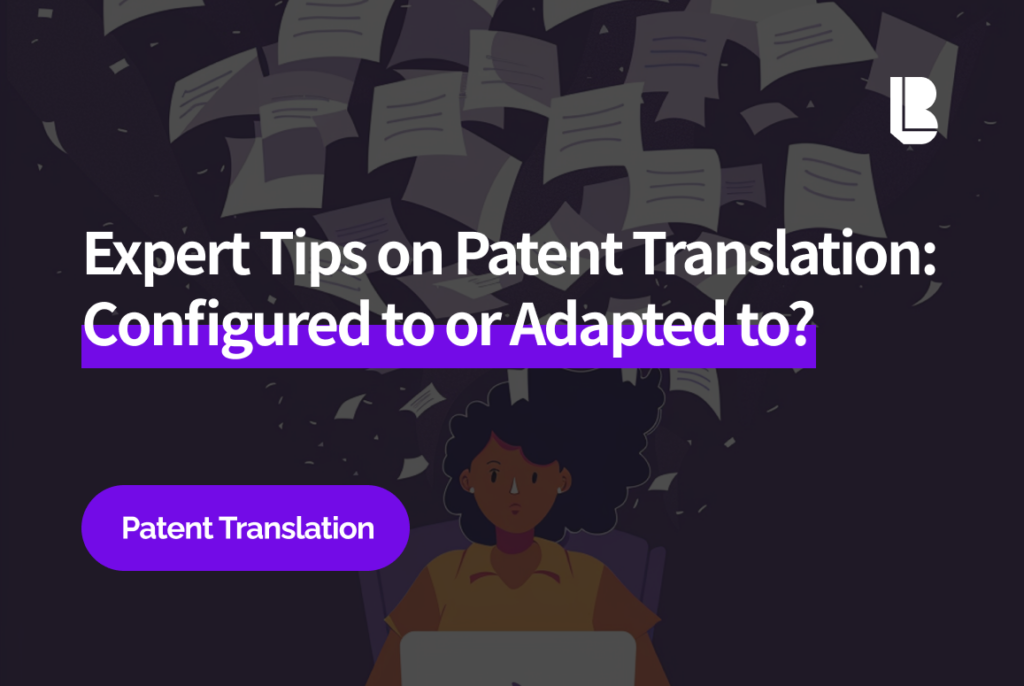Today, we will discuss the frequently encountered phrase ‘configured to’ in patent translations. Patent translation, especially the translation of claims, is critical as it defines the scope of an invention’s rights. Therefore, it requires utmost attention and precision.
In many Korean patent specifications, you may often come across the expression ‘…하도록 구성된’, which means that a component of the invention is designed to perform a specific function. However, when translating this into English, there can be some confusion.
Phrases like ‘configured to‘ and ‘adapted to‘ are commonly used, but the choice goes beyond simple vocabulary – it also involves an understanding of patent law and interpretation practices. Without the right expertise, it can be difficult to decide which term to use. Today, we will explore the differences between these expressions and how to use them correctly. If you’re interested in patent translation, make sure to stay with us until the end!
✅ Bering Lab’s Translation Notes for Today
- Example of Korean to English translation of “a memory configured to store information”
- Various expressions for translating ‘…하도록 구성된’
- ‘Configured to’ vs. ‘Adapted to’
- Three important considerations for drafting patent claims
✍🏻 Different Ways to Translate ‘…도록 구성된’
How can we translate the common Korean phrase ‘…도록 구성된’ in patent specifications into English? While there are several options, the most commonly used expression is ‘configured to’.
For example, how would you translate the phrase “정보를 저장하도록 구성된 메모리 (a memory configured to store information)” into English?
The reason for this translation shift is that the older approach could be interpreted legally as “the means (memory) + function (storing information)”, which might lead to the question, “Is this memory only for storing information?” Such interpretations could narrow the scope of patent protection. Therefore, a different translation method is used to avoid such misinterpretations.
You could also translate it as “a memory that stores information”, which is grammatically correct but may imply that the memory must always store information. Therefore, this is rarely used unless in specific contexts. Besides ‘configured to’, there are other expressions. The meaning and relative scope of each term vary, and while there is no absolute standard, the slightest difference in wording can significantly affect the scope of patent protection.
✍🏻 Understanding ‘Configured to’ vs. ‘Adapted to’ Through the Aspex Case
Although ‘configured to’ and ‘adapted to’ may seem similar at first glance, they can create significant differences in patent claims. Let’s explore the differences and how these phrases impact patent claims through the case of Aspex Eyewear, Inc. v. Marchon Eyewear, Inc. (the “Aspex Case”).
In the Aspex case, the court made an important interpretation of ‘configured to’. The court ruled that it does not simply refer to a structure that can perform a function, but to a structure specifically designed to perform that function. For example, if a device is “configured to transmit data”, it means the device is specifically designed to transmit data.
On the other hand, ‘adapted to’ can be interpreted more broadly. The court explained that this phrase can be interpreted narrowly, similar to ‘configured to’, or more broadly, as simply the ability to perform a function. For example, a device “adapted to transmit data” could imply that it has the ability to transmit data but was not necessarily designed for that purpose.
This case highlights the importance of word choice in drafting patent claims. Using ‘configured to’ might narrow the scope of rights but increase the chances of patent approval. In contrast, ‘adapted to’ might provide broader protection but leave room for different interpretations, requiring caution.
✍🏻 Important Considerations for Drafting Patent Claims
Drafting patent claims is crucial as it defines the scope of an invention’s rights. Based on the differences between ‘configured to’ and ‘adapted to’, here are three important considerations when drafting claims:
- Be cautious with the interpretation of ‘adapted to’. While ‘adapted to’ generally implies a broader scope of rights, be aware that courts might interpret it narrowly. For instance, a device “adapted to transmit data” could be interpreted by a court as not merely capable of transmitting data, but actually designed for that purpose.
- Understand USPTO’s interpretation of ‘configured to’. The U.S. Patent and Trademark Office (USPTO) often interprets ‘configured to’ as ‘capable of’. This may lead to patent rejection based on prior art. For instance, if you file a patent for a smartphone “configured to transmit data”, the USPTO may reject it on the grounds that regular phones can also transmit data.
- Use broader functional expressions. If you want to secure a broader claim scope, consider using expressions like ‘suitable for’, ‘capable of’, or ‘having the capacity to’. These phrases may provide broader rights but can also lead to different interpretations, so caution is advised.
Choosing the right wording in patent translation is complex, and a single word can change the fate of a patent. This is why it’s crucial to use a specialized legal translation tool like BeringAI, which understands these subtle legal differences.
🚀 High-quality, accurate patent translations are essential for international filings!
We’ve explored how the phrase ‘configured to’ can be translated and interpreted in various ways, and how this small difference can have a big impact on the scope of patent rights. Isn’t it fascinating? Laws are always changing, so securing broad claim coverage with appropriate translations is essential.
Why not try using BeringAI for your complex patent translations? BeringAI is not just a simple translation tool; it’s an AI translation engine specifically designed for legal and patent documents. It provides results that are most similar to the original document, while maintaining the formatting, saving you time and effort on post-editing. BeringAI’s performance is 2-6 times better than Google, Papago, and DeepL, as demonstrated by BLEU scores.
The future of patent translation is evolving with AI. At BeringLab, our goal is to let legal professionals focus on their expertise while BeringAI takes care of the legal translations. Step away from the complexities of translation work and focus on your core tasks—BeringAI will be your reliable partner.
🚀 Try BeringAI for free today. Experience the incredible performance and see how it transforms your patent translation work efficiently. We hope this Bering Lab Translation Note has been useful, and we’ll be back with more insights next time.

